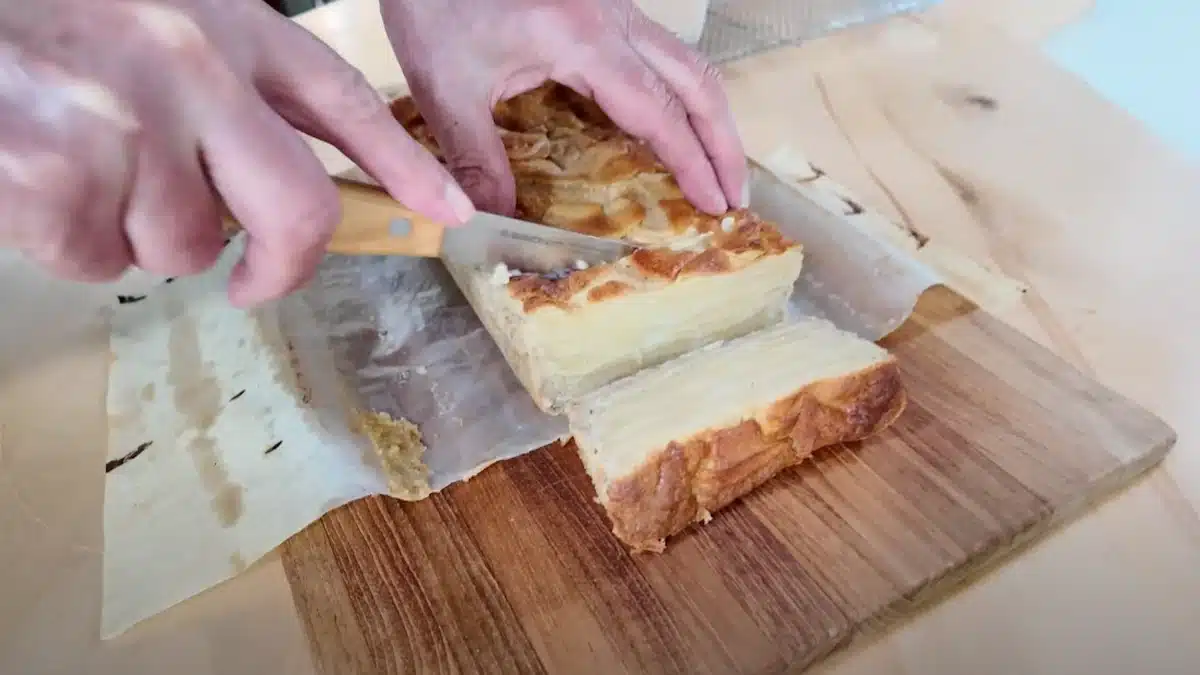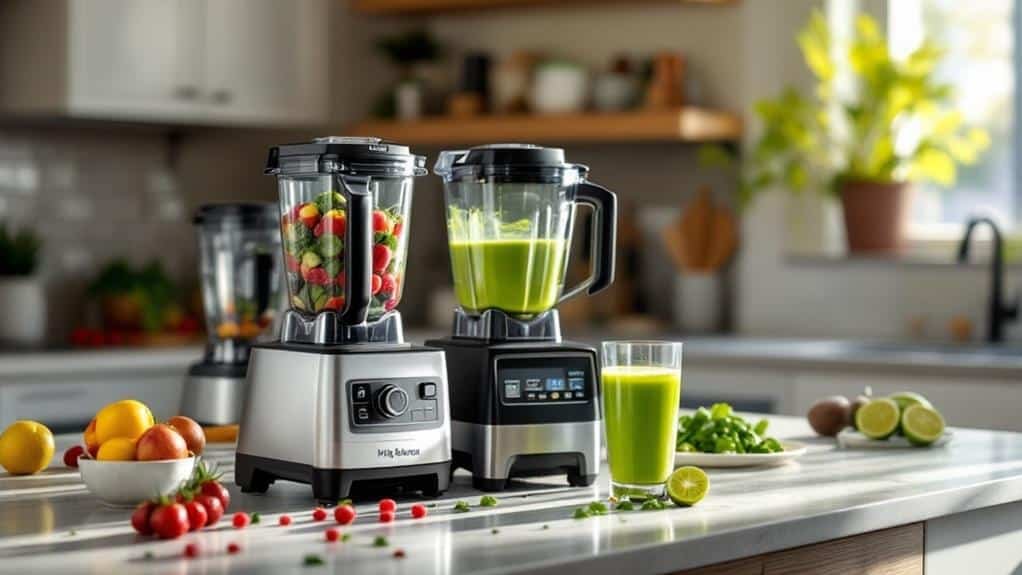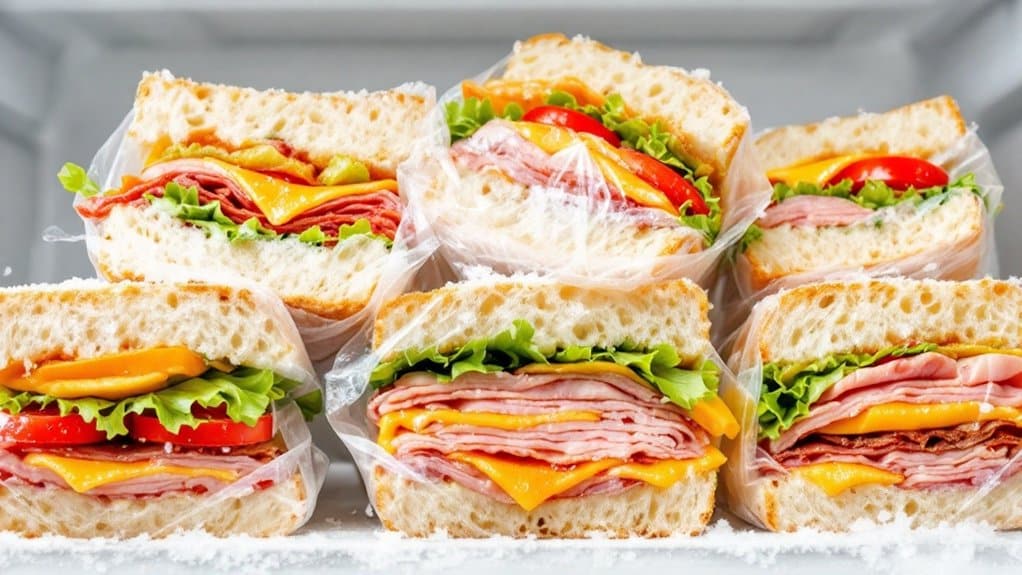Want pro-level sandwich veggies? Let’s transform your sandwich game with our top mandoline tips. Always use the hand guard and cut-resistant gloves for safety, and maintain a consistent pressure for uniform slices. We recommend 1/16 inch for crisp cucumbers and radishes, while tomatoes need a thicker 1/4 inch cut. Store your sliced vegetables in airtight containers with a paper towel to absorb excess moisture, and toss acid-sensitive produce in lemon water to prevent browning. Keep your mandoline clean with a dedicated soft brush, and always store it blade-down with the safety lock engaged. These basics are just the beginning of your journey to sandwich perfection.
Key Highlights
- Set mandoline thickness to 1/16 inch for crunchy cucumbers and radishes, or 1/8 inch for heartier vegetables like carrots.
- Always use the hand guard and cut-resistant gloves to ensure safety while achieving consistently thin slices.
- Prepare vegetables in bulk and store in airtight containers with paper towels to maintain freshness for 3-4 days.
- Slice firm vegetables like cucumbers, carrots, and onions paper-thin to enhance texture and flavor distribution.
- Keep sliced vegetables separate and toss acid-sensitive produce in lemon water to prevent oxidation and maintain crispness.
Safety Tips for Mandoline Use
Safety remains paramount when using a mandoline slicer. We’ve all heard horror stories about kitchen accidents, and we’re here to make sure you keep all your fingers intact while creating those perfect sandwich slices.
Let’s start with hand safety – it’s non-negotiable. Always use the hand guard that comes with your mandoline, even if you think you’ve got steady hands. Trust us, that extra few seconds it takes to attach the guard is worth avoiding a trip to the emergency room.
When we’re working with vegetables, especially firm ones like carrots or radishes, we need to maintain consistent pressure and keep our fingers well above the blade area. Remember, rushing through your prep work isn’t worth risking an injury.
Blade protection is just as essential when you’re not using the mandoline. We always store ours with the blade facing down and the safety lock engaged. If your model came with a blade cover, use it religiously.
Here’s a pro tip we’ve learned the hard way: invest in a cut-resistant glove. It’s like insurance for your fingers, and you’ll slice with more confidence.
Preparing vegetables in advance using a mandoline and storing them in vacuum-sealed containers will help maintain their freshness and make sandwich assembly quick and efficient.
Choosing the Right Mandoline
Now that we’ve covered staying safe, let’s talk about picking the perfect mandoline for your kitchen. After years of testing different models, we’ve learned that the right mandoline can make all the difference in your sandwich game.
When exploring mandoline features, you’ll want to focus on three key elements: stability, blade options, and adjustability. We love models with wide, non-slip bases that won’t wobble while you’re working your slicing techniques. Trust us – there’s nothing worse than a wobbly mandoline when you’re trying to achieve those paper-thin cucumber rounds.
Look for a mandoline that offers multiple blade settings. The best ones let you switch between straight cuts, wavy cuts, and different thickness levels. We’ve found that the sweet spot for sandwich veggies is usually between 1-3mm thick, but you’ll want the freedom to experiment.
Don’t feel pressured to buy the most expensive model. A mid-range mandoline with solid construction and basic features will serve you well. Just make sure it has comfortable hand grips and easy-to-use adjustment knobs. These small details make a big difference when you’re prepping vegetables for multiple sandwiches.
With proper care and maintenance, a quality mandoline slicer can remain effective for 3-5 years or even longer.
Perfect Thickness Settings
Every vegetable demands its perfect thickness for ideal sandwich texture and flavor. Through countless trials (and a few amusing mishaps), we’ve found that different vegetables shine at different settings on your mandoline.
We love going super thin – about 1/16 inch for cucumbers and radishes. This delicate thickness lets them practically melt into your sandwich while still providing that satisfying crunch. Plus, they’re less likely to slide out when you take a bite!
Firmer vegetables like carrots and beets need a slightly thicker cut, around 1/8 inch. These slicing techniques guarantee they’ll cook evenly if you’re planning to quick-pickle them, and they’ll hold their own against heartier sandwich fillings.
Tomatoes are the trickiest customer – we recommend a more generous 1/4 inch slice. Any thinner and they’ll turn your bread into a soggy mess (we learned that one the hard way).
Best Vegetables for Slicing
A mandoline’s razor-sharp blade transforms certain vegetables into sandwich-worthy masterpieces, while others are best left to traditional knife work. We’ve tested countless colorful vegetables to determine which ones truly shine when sliced on a mandoline.
Firm vegetables like cucumbers, radishes, and carrots are perfect candidates. They maintain their shape beautifully and create those satisfyingly thin, uniform slices we love. We can’t recommend fennel enough for maximum crunch and visual appeal – those delicate, translucent crescents add texture and subtle flavor profiles to any sandwich.
Onions and bell peppers also perform wonderfully on a mandoline. We’ve found that red onions, sliced paper-thin, lose their harsh bite while keeping their gorgeous purple hue. And there’s something magical about rainbow bell peppers when they’re sliced so precisely – they literally transform an ordinary sandwich into edible art.
Steer clear of softer vegetables like tomatoes or avocados – trust us, we’ve learned this the hard way. These delicate beauties deserve the gentle touch of a sharp knife instead. Remember, if a vegetable feels mushy under gentle pressure, it’s probably not mandoline-friendly.
These thinly sliced vegetables are perfect for creating heart-healthy stir-fries that maintain their nutrients through quick cooking methods.
Storage of Sliced Vegetables
Once you’ve mastered the perfect mandoline cuts, proper storage becomes your next challenge. We’ve found that keeping those beautiful slices fresh is just as important as the cutting technique itself.
Let’s look at the best storage methods for your most common sandwich veggies:
| Vegetable | Storage Method |
|---|---|
| Cucumber | Paper towel-lined container, 3-4 days |
| Tomatoes | Vacuum sealed bags, 5-7 days |
| Onions | Airtight container with water, 7 days |
| Lettuce | Salad spinner, then sealed bag, 5 days |
We’ve learned that refrigeration methods make all the difference in maintaining that perfect crunch. Vacuum sealing is our go-to for longer storage – it’s like giving your veggies a time capsule!
Never store your sliced vegetables without some form of moisture control. We keep paper towels handy to absorb excess water, which is often the culprit behind soggy sandwiches. Trust us, there’s nothing worse than pulling out yesterday’s perfectly sliced cucumbers only to find them wilted and sad.
For best results, slice vegetables as you need them. But when you must prep ahead, these storage techniques will keep your ingredients sandwich-ready.
Using durable containers for vegetable storage can save you an average of $2,500 annually by preventing food waste and encouraging more packed lunches.
Layering Techniques for Sandwiches
Three key principles guide the perfect layering of mandoline-sliced vegetables in sandwiches: moisture control, texture balance, and structural integrity. We’ve learned through countless sandwich builds that these elements make the difference between a soggy mess and a masterpiece.
Let’s start from the bottom up. Place your sturdier veggies like cucumber and radishes closest to the bread, creating a moisture barrier that protects your base. We love how these crisp foundations contribute to both structural support and layering flavors.
For the middle layer, we’ll arrange your delicate ingredients like tomatoes and lettuce. Think about visual appeal here – those paper-thin, mandoline-cut vegetables create beautiful, colorful stripes that’ll make your sandwich Instagram-worthy.
The top layer’s all about protection. We typically finish with dense vegetables like shaved carrots or bell peppers, which help hold everything in place. It’s like creating a protective dome for all those precious ingredients below.
This layering technique works especially well in a veggie-packed grilled cheese that combines melted cheese with fresh, crisp vegetables for an elevated twist on the classic sandwich.
Quick Prep Time Strategies
Time-saving mastery with mandolines starts by establishing an efficient prep station. We’ll set up our workspace with three essential zones: cleaning, cutting, and storage. This organization lets us move through our prep like a well-oiled machine.
Let’s break down our favorite batch preparation approach that’ll save you precious minutes:
| Prep Stage | Time-Saving Action | Storage Tips |
|---|---|---|
| Set-up | Gather all tools first | Keep containers ready |
| Washing | Bulk wash vegetables | Pat dry completely |
| Cutting | Use mandoline guard | Stack as you slice |
| Portioning | Divide into meal sizes | Label with date |
| Storage | Use airtight containers | Keep moisture low |
We’re big fans of prepping enough vegetables for 3-4 days of sandwiches. It’s a game-changer for busy schedules! Just remember to keep your cucumber and tomato slices separate from other veggies – they’ll stay fresher that way.
One of our favorite time-saving techniques is to prep while listening to podcasts or music. It turns routine slicing into an enjoyable ritual, and before you know it, you’ve got a week’s worth of perfectly cut veggies ready to go.
Texture Combinations That Work
Texture-layering mastery takes your sandwich from ordinary to extraordinary. We’ve found that mandoline-sliced vegetables create the perfect foundation for building crunchy contrasts that’ll make every bite memorable.
Let’s start with the classics: paper-thin cucumber ribbons paired with thicker tomato slices create an immediate textural intrigue. We love how the delicate crunch plays against the juicy softness – it’s like a little party in your mouth!
When we layer mandoline-shaved carrots with creamy avocado, we’re hitting that sweet spot of flavor balance. The crisp-tender vegetables provide just enough resistance without overwhelming softer elements. It’s all about building those perfect bites.
Think about combining shaved fennel’s delicate crispness with hearty roasted peppers, or whisper-thin radish slices with thick-cut mozzarella. These pairings aren’t just random – they’re carefully orchestrated texture symphonies.
For maximum impact, we always recommend alternating your mandoline cuts between paper-thin and slightly thicker slices. This simple technique creates depth that’ll have your friends wondering if you’ve secretly been attending culinary school.
Preventing Vegetable Oxidation
While achieving perfect textures with mandoline-sliced vegetables elevates your sandwich game, keeping those pristine cuts looking fresh poses its own challenge. We’ve all been there – those perfectly sliced apples or avocados turning an unappetizing brown before we can even finish building our masterpiece.
Let’s tackle these oxidation factors head-on with some proven prevention techniques that’ll keep your veggies looking as fresh as the moment they met the mandoline. The key is acting fast and smart.
Here are our top three methods that really work:
- Toss acid-sensitive vegetables like apples and pears in a mixture of water and lemon juice immediately after slicing
- Store cut vegetables in cold water with a splash of vinegar – this works wonders for potatoes and other root vegetables
- Pack sliced avocados tightly with plastic wrap, removing as much air as possible, and spritz with lime juice
Cleaning Your Mandoline Properly
Every mandoline blade requires thorough cleaning after use to prevent cross-contamination and maintain its razor-sharp edge. We’ve learned through countless sandwich prep sessions that a clean mandoline isn’t just about food safety – it’s about preserving your investment and ensuring consistently beautiful cuts every time.
Let’s start with our go-to cleaning techniques. First, we’ll rinse the mandoline with warm water immediately after use – this prevents those stubborn dried-on bits that we all dread. Then, using a soft-bristled brush (never steel wool!), we’ll gently scrub in the direction of the blade with mild soap and water.
One of our favorite maintenance tips is to keep a designated cleaning brush just for your mandoline. We’ve found this helps prevent the blades from getting damaged or dulled by harsh scrubbing tools.
After cleaning, we always pat our mandoline dry with a clean kitchen towel. Never let it air dry – trust us, we learned this lesson the hard way when rust spots appeared on our first mandoline. Store it in a dry place, preferably with the blade guard on, and it’ll be ready for your next sandwich-making adventure.
To Sum it Up
We’ve covered a lot of ground in mastering the art of mandoline-cut vegetables for sandwiches. From safety precautions to storage tips, these techniques will transform your sandwich game. Remember, practice makes perfect – your first few attempts might not be Instagram-worthy, but stick with it! Once you’ve mastered these skills, you’ll wonder how you ever made sandwiches without perfectly sliced vegetables. Now, get out there and start slicing!









